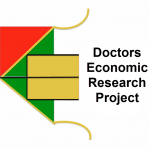 The Doctors Economic Research Project was initiated in 1974 to study the economics of doctors’ lives and the effect of economic stress on professional performance. Findings of the research identified correlations between financial instability (as quantified by savings levels) and the incidence of depression and malpractice claims.
The Doctors Economic Research Project was initiated in 1974 to study the economics of doctors’ lives and the effect of economic stress on professional performance. Findings of the research identified correlations between financial instability (as quantified by savings levels) and the incidence of depression and malpractice claims.
Two questions were asked of more than 500,000 doctors who attended economic education seminars, over three generations, where findings of the research were presented. The questions were: 1. What do you need to KNOW to succeed financially? and 2. What do you need to HAVE to succeed financially? Findings of the research project identified that doctors needed to understand compound interest in the context of their own life expectancies. Two models were developed, one to illustrate a productive doctor’s economic life cycle, and another to illustrate the priority allocation of their earnings.
At the request of doctors participating in the research projects, the capability to quantify these models in doctors’ personal circumstances was developed, and planning programs were created to implement the planning principals and rules that had been derived from findings of the research projects. More than 60,000 doctors participated in research-based earnings management, savings management, and endowment creation planning programs. Information gathered from doctors participating in the planning program was accumulated to create the largest data base in existence on the economics of doctors’ lives.
The evidence-based planning principals that were developed are: 1. Don’t lose earnings to unnecessary income taxes, and 2. Don’t lose savings to unnecessary risk investments. Two planning objectives were identified: 1. To achieve financial independence, and 2. To achieve personal significance. Financial independence was defined as guaranteed life income that equals lifestyle costs. Personal significance was defined as the gifting of surplus savings to family members and/or to non-profit organizations to perpetuate values of importance to doctors, to their families, and to society.
The achievement of financial independence is the goal of the capital accumulation phase of a doctor’s economic life cycle, and the achievement of personal significance is the goal of the capital distribution phase of a doctor’s economic life cycle. Planning rules were developed to monetize financial independence and personal stability for doctors by maximizing the efficiency, control, and safety of the conversion of their surplus earnings to savings during the capital accumulation phase of their economic lifecycles and by maximizing the efficiency, control, and safety of the conversion of their surplus savings exceeding lifestyle costs through life expectancy to create perpetually multiplying endowment funding.
The need to minimize doctors’ losses of surplus earnings to unnecessary income taxes led to a study of tax law to identify provisions of the tax code that created planning programs that maximized the efficiency of the conversion of doctors’ surplus earnings to earnings and asset protection programs, to savings, and to guaranteed life income, and maximized the conversion of doctors’ surplus savings to gifts to create perpetually multiplying endowment funding. Doctors who had $30,000, or more, of annual surplus earnings and/or $250,000, or more, of assets they controlled qualified for access to earnings management, catastrophic loss protection, and guaranteed life income accumulation planning that prevented the loss of $1,000,000, or more, of retirement savings.
Maximum efficiency was also defined as the prevention of periodic losses of principal to risk investments in order to maximize compound interest growth. Maximum control was defined as personal ownership of employers, income and asset protection programs, and savings accumulations. Maximum safety was defined as guarantees of savings by government regulated institutions. Only the legal reserve life insurance companies operate under provisions of the law that provide for institutionally guaranteed principal, tax-free growth, and guaranteed life income. Commercial banks provide access to insured principal and taxable growth, and investment banks provide access to risk of principal and taxable growth. Periodic losses of savings destroy the efficiency of compound interest.
Maximum efficiency outcomes were also achieved for participating doctors by deploying leverage to increase annual pension savings. One leveraged program generates taxable distributions and the other generates tax-free distributions. Findings of the research demonstrated the value of the stability of doctors’ career earnings in gaining access to loans that materially increased retirement savings.